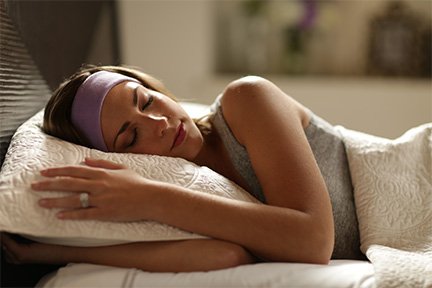Sleep Restriction Therapy: A Liberating Treatment for People with Insomnia Disorder

Psychologists have found, since 1987, that restricting a person’s time in bed can address the roots of insomnia.
Despite how counterintuitive this treatment may sound—how do people with insomnia get more sleep by not staying in bed?—sleep restriction therapy can help the 6-10 percent of people whose insomnia fits the definition of a disorder. In fact, the group of therapies this treatment belongs to had been formally endorsed by the American College of Physicians to treat insomnia. Quite a large feat, as Tori DeAngelis from the American Psychological Association writes: “It's the first time a psychological treatment has been given the thumbs up as the preferred treatment by a medical organization, at least in the United States.”
We define insomnia disorder before describing sleep restriction therapy in more depth. Although it has proven to be effective, this treatment might be unavailable to most people and require a lot of time, money, and effort. Fortunately, people with insomnia have long incorporated SleepPhones® into their nightly routine. They may benefit from a combination of professional therapy and our clinically-proven sound technology.
“I wake up almost every night, but after a lifetime of insomnia, it's no longer a problem. I put on my SleepPhones® and fall back to sleep within 5 minutes.” — Christie Olson Day (@christieoday)
What is Insomnia Disorder?
People may think of insomnia as only difficulty falling asleep. The American Psychiatric Association writes that this definition also includes difficulty staying asleep, as well as waking up earlier than someone would like.
To qualify as a disorder, however, insomnia must meet four main criteria:
- Persist at least three times a week for at least three months.
- Occur despite otherwise normal circumstances for sleep, such as the time of day and the bedroom environment.
- Impair a person’s ability to focus on tasks, remember details, learn information, and be cheerful.
- Exist independently of other disorders—such as depression, anxiety, substance-abuse, and other sleep disorders—as well as medical conditions and medications.
This definition is necessary for health professionals to target insomnia specifically. That’s where sleep restriction therapy comes in.
What is Sleep Restriction Therapy, and How Does it Alleviate Insomnia?
Sleep restriction therapy fits under the category of cognitive behavioral therapies, or CBT. These therapies are used for various other disorders, even those that are not directly related to sleep. Essentially, they aim to change how people respond to psychological triggers both in their thoughts and actions.
CBTs for insomnia disorder, then, would help people approach sleep more adequately. That way, they can put their sleeplessness into remission.
While there are various CBTs for insomnia, the logic underlying sleep restriction therapy is this: People with insomnia disorder are not effectively using the time they spend in bed. They lose sleep because two essential processes are misaligned: the circadian rhythm, our “internal clock” that dictates the time for sleep and wakefulness based on environmental light; and the homeostatic drive, our brains’ way of pressuring us to sleep the longer we are awake. For example, your circadian rhythm might say it’s time to go to bed because it’s dark outside; however, if you napped for too long in the afternoon, then the homeostatic drive is set back a few hours, making it hard to fall asleep at bedtime. Sleep restriction therapy therefore acts as a reset button, slowly bringing these two processes back into alignment.
So, how does it work? First, the therapist requires the patient to keep a log of the time spent sleeping versus the total time in bed. The wasted hours spent in bed are then cut from the patient’s sleep schedule, which is now restricted only to the hours previously spent sleeping. For example, if the patient only sleeps for 5 out of 8 hours, as Rachel R. Markwald and others explain, then the patient should now sleep only 5 hours a night. Over the next few days, if the patient falls asleep more quickly and experiences fewer sleep disturbances, the therapist allots 15-30 minutes each night and may change either the bedtime or the waking time. However, if the patient’s sleep does not improve, then the therapist will restrict the total sleeping time each night by those same 15-30 minute increments. (Note that, to prevent excessive drowsiness during the day, the restricted time will never drop below 5 hours.) Ideally, by the end of treatment, the patient’s allotted sleeping time will be restored to the 7-8 hour recommendation for the average adult.
How Effective is Sleep Restriction Therapy?

Across the scientific literature, behavioral therapies have proven to be far more effective at treating chronic insomnia than medication. Where specific therapies are concerned, sleep restriction therapy ranks near the top.
In 2012, reviewers at the National Institute of Mental Health and Neurosciences in India wrote that sleep restriction therapy produces effect sizes equal to stimulus control therapy, the most effective stand-alone standard treatment for insomnia disorder. More recently, nursing researchers found that it can also function as its own stand-alone treatment, having allowed participants to fall asleep in less than 20 minutes with minimal nightly awakenings. Although future evidence needs to examine the limitations of sleep restriction therapy, it has so far been an overall benefit for people with insomnia disorder.
At any rate, sleep restriction therapy has shown to be far more effective in the long-term than mere sleep hygiene education, which teaches healthy sleep habits such as restricting caffeine intake and avoiding naps. Although these habits can prevent insomnia from worsening, they ineffectively treat the most chronic cases.
How can SleepPhones® Headphones Assist People with Sleep Restriction Therapy?
Sleep restriction therapy is an effective CBT treatment because it retrains your sleep associations to be positive, reducing the anxiety of chronic insomnia. SleepPhones® headphones can be an integral part of that association retraining. It's very helpful when developing a new bedtime routine to break things up a bit so one doesn't slip back into old habits. The SleepPhones® headphones allow a patient to listen to soothing sounds in bed, which may be just enough of a new thing to really stimulate changes in sleep associations. As a patient begins the sleep restricted schedule, also begin using SleepPhones® headphones at bedtime, with whatever sounds are most relaxing. Keep listening to similar sounds each night as the restrictions ease. Over time, playing soothing sounds with SleepPhones® headphones will become part of a relaxing bedtime routine. This routine makes it easier to sleep despite changes to a schedule, such as with travel, kids, or daylight savings.
If you suspect that you or someone close to you has insomnia disorder, please consult a medical professional. In the meantime or during treatment, put your worries to rest with our patented SleepPhones® technology. With models ranging from $39-$149, you can listen to any sort of music, TV, podcast, or audiobook that helps you sleep more easily.
“I listen to an audiobook with SleepPhones … to shut out the surge of creative thoughts and set it to turn off in half hour. Does the trick. Radical life hack for me. Turned years of insomnia around.” — Tobias S. Buckell
Find more about insomnia here.
